Operations Management Report: Operational Strategies at Land Rover
VerifiedAdded on 2020/12/10
|11
|2724
|104
Report
AI Summary
This report provides a comprehensive analysis of operations management, using Land Rover as a case study. It delves into key aspects such as operational scheduling, including forward and backward scheduling, along with techniques like preemptive and non-preemptive scheduling, FCFS, and shortest job first. The report also examines layout planning and work system processes, emphasizing the importance of efficient resource allocation. Furthermore, it highlights the significance of inventory management policies in controlling production costs, discussing how these policies minimize risks and optimize financial resources. The conclusion underscores the importance of effective operations management for organizational growth and success.
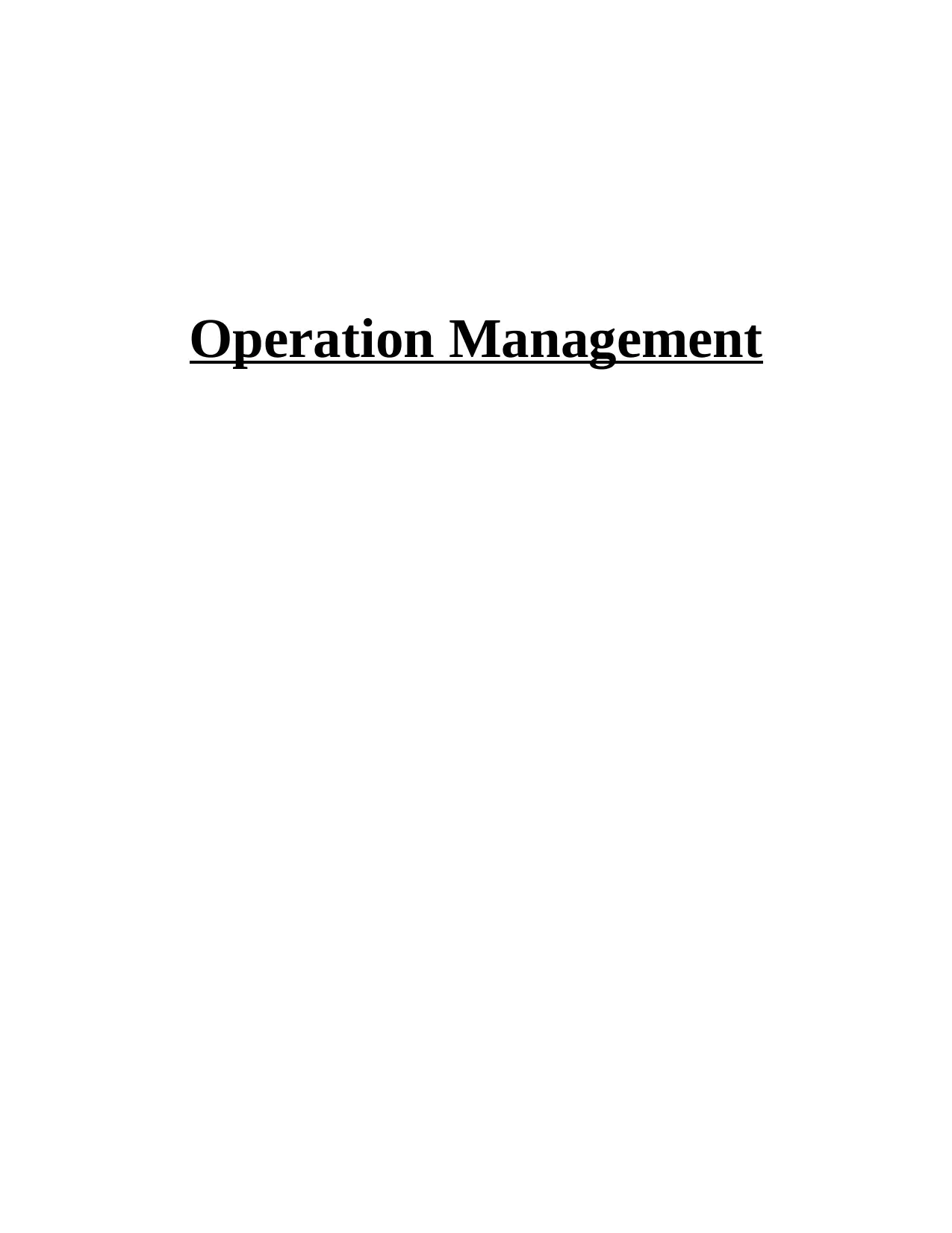
Operation Management
Paraphrase This Document
Need a fresh take? Get an instant paraphrase of this document with our AI Paraphraser
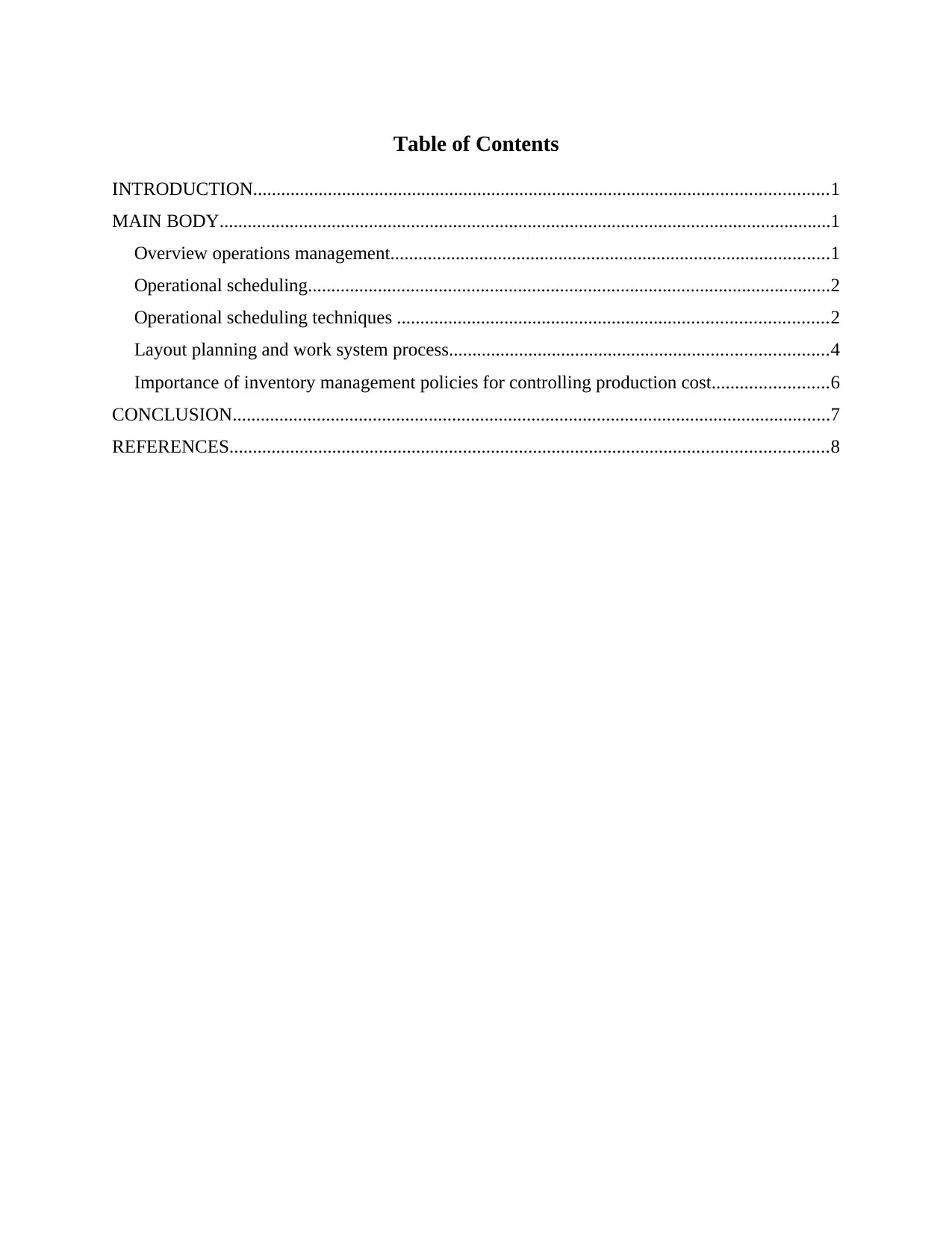
Table of Contents
INTRODUCTION...........................................................................................................................1
MAIN BODY...................................................................................................................................1
Overview operations management..............................................................................................1
Operational scheduling................................................................................................................2
Operational scheduling techniques ............................................................................................2
Layout planning and work system process.................................................................................4
Importance of inventory management policies for controlling production cost.........................6
CONCLUSION................................................................................................................................7
REFERENCES................................................................................................................................8
INTRODUCTION...........................................................................................................................1
MAIN BODY...................................................................................................................................1
Overview operations management..............................................................................................1
Operational scheduling................................................................................................................2
Operational scheduling techniques ............................................................................................2
Layout planning and work system process.................................................................................4
Importance of inventory management policies for controlling production cost.........................6
CONCLUSION................................................................................................................................7
REFERENCES................................................................................................................................8

INTRODUCTION
Operations management may be defined as the administrations of business practices
which helps in creating highest level of efficiency within the organisation. Operations
management helps in converting the resources into desired goods and services and very buiness
success is managed though effective operations management (Seddighi and Mathew, 2018).
Operation management can help the organisations in achieving success in business and also
helps in fulfilling the business objectives by producing right kind of goods and service which are
capable for satisfying the customer's needs. In this report Land Rover is taken as a company,
which is a British multinational car manufacturing company. This report discusses about the
operational scheduling techniques when an organisation works. This report also include the
layout planning and work system processes of Land Rover within the business. Present report
also discusses about importance of inventory management policies in order to control
organisation's production cost.
MAIN BODY
Overview operations management
Operation management is the important part of Land Rover which help the organisation
in manufacturing the cars with effective use of resources like labour, money, raw materials and
other resources in an organisation. With the help proper management is the operations
department an organisation can improve its over all productivity. It is primarly concerned with
the planning, supervising and organising in areas of production and manufacturing processes. It
helps to create high level of possible efficiency within the organisation (Tanabe,
2019).Operations management is also concerned with converting raw materials into goods and
services with the effective use of labours in an organisation which results in maximising the
profits of an organisation. Operations management mainly focuses on careful management of
process to produce and distribute the products and services. Operations management helps the
organisation in understanding the role of operations management within the company and also
helps to reduce production costs, improve the quality of products and reduce the delivery times it
can also embrace flexibility within the organisation and embraces innovations. Operation
management help in optimum utilisation of the resources which can lead to the enormous profits
for an organisation. Operations management is important for a business as it helps in improving
the product quality and also involves the continuous improvements in products and service
1
Operations management may be defined as the administrations of business practices
which helps in creating highest level of efficiency within the organisation. Operations
management helps in converting the resources into desired goods and services and very buiness
success is managed though effective operations management (Seddighi and Mathew, 2018).
Operation management can help the organisations in achieving success in business and also
helps in fulfilling the business objectives by producing right kind of goods and service which are
capable for satisfying the customer's needs. In this report Land Rover is taken as a company,
which is a British multinational car manufacturing company. This report discusses about the
operational scheduling techniques when an organisation works. This report also include the
layout planning and work system processes of Land Rover within the business. Present report
also discusses about importance of inventory management policies in order to control
organisation's production cost.
MAIN BODY
Overview operations management
Operation management is the important part of Land Rover which help the organisation
in manufacturing the cars with effective use of resources like labour, money, raw materials and
other resources in an organisation. With the help proper management is the operations
department an organisation can improve its over all productivity. It is primarly concerned with
the planning, supervising and organising in areas of production and manufacturing processes. It
helps to create high level of possible efficiency within the organisation (Tanabe,
2019).Operations management is also concerned with converting raw materials into goods and
services with the effective use of labours in an organisation which results in maximising the
profits of an organisation. Operations management mainly focuses on careful management of
process to produce and distribute the products and services. Operations management helps the
organisation in understanding the role of operations management within the company and also
helps to reduce production costs, improve the quality of products and reduce the delivery times it
can also embrace flexibility within the organisation and embraces innovations. Operation
management help in optimum utilisation of the resources which can lead to the enormous profits
for an organisation. Operations management is important for a business as it helps in improving
the product quality and also involves the continuous improvements in products and service
1
⊘ This is a preview!⊘
Do you want full access?
Subscribe today to unlock all pages.

Trusted by 1+ million students worldwide
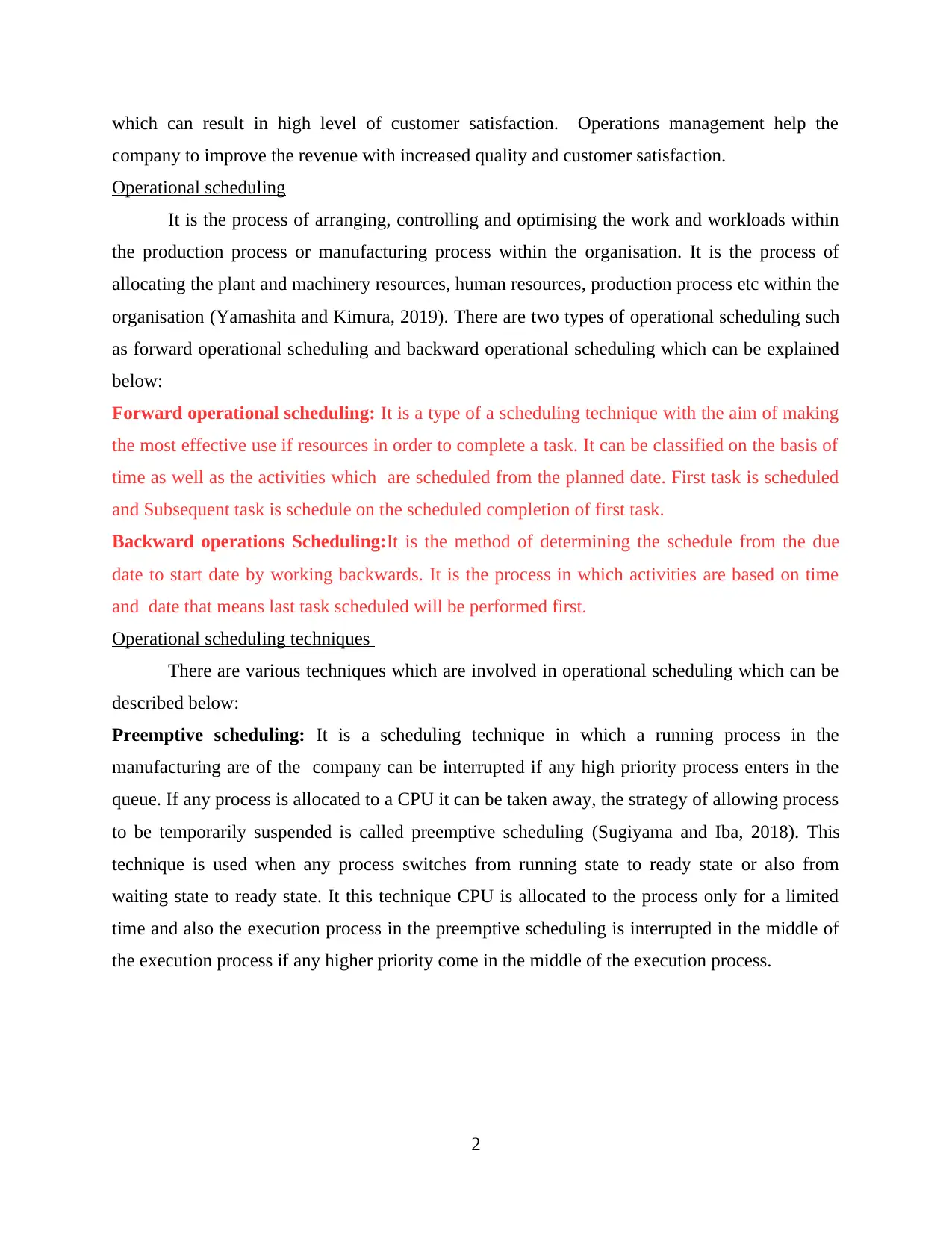
which can result in high level of customer satisfaction. Operations management help the
company to improve the revenue with increased quality and customer satisfaction.
Operational scheduling
It is the process of arranging, controlling and optimising the work and workloads within
the production process or manufacturing process within the organisation. It is the process of
allocating the plant and machinery resources, human resources, production process etc within the
organisation (Yamashita and Kimura, 2019). There are two types of operational scheduling such
as forward operational scheduling and backward operational scheduling which can be explained
below:
Forward operational scheduling: It is a type of a scheduling technique with the aim of making
the most effective use if resources in order to complete a task. It can be classified on the basis of
time as well as the activities which are scheduled from the planned date. First task is scheduled
and Subsequent task is schedule on the scheduled completion of first task.
Backward operations Scheduling:It is the method of determining the schedule from the due
date to start date by working backwards. It is the process in which activities are based on time
and date that means last task scheduled will be performed first.
Operational scheduling techniques
There are various techniques which are involved in operational scheduling which can be
described below:
Preemptive scheduling: It is a scheduling technique in which a running process in the
manufacturing are of the company can be interrupted if any high priority process enters in the
queue. If any process is allocated to a CPU it can be taken away, the strategy of allowing process
to be temporarily suspended is called preemptive scheduling (Sugiyama and Iba, 2018). This
technique is used when any process switches from running state to ready state or also from
waiting state to ready state. It this technique CPU is allocated to the process only for a limited
time and also the execution process in the preemptive scheduling is interrupted in the middle of
the execution process if any higher priority come in the middle of the execution process.
2
company to improve the revenue with increased quality and customer satisfaction.
Operational scheduling
It is the process of arranging, controlling and optimising the work and workloads within
the production process or manufacturing process within the organisation. It is the process of
allocating the plant and machinery resources, human resources, production process etc within the
organisation (Yamashita and Kimura, 2019). There are two types of operational scheduling such
as forward operational scheduling and backward operational scheduling which can be explained
below:
Forward operational scheduling: It is a type of a scheduling technique with the aim of making
the most effective use if resources in order to complete a task. It can be classified on the basis of
time as well as the activities which are scheduled from the planned date. First task is scheduled
and Subsequent task is schedule on the scheduled completion of first task.
Backward operations Scheduling:It is the method of determining the schedule from the due
date to start date by working backwards. It is the process in which activities are based on time
and date that means last task scheduled will be performed first.
Operational scheduling techniques
There are various techniques which are involved in operational scheduling which can be
described below:
Preemptive scheduling: It is a scheduling technique in which a running process in the
manufacturing are of the company can be interrupted if any high priority process enters in the
queue. If any process is allocated to a CPU it can be taken away, the strategy of allowing process
to be temporarily suspended is called preemptive scheduling (Sugiyama and Iba, 2018). This
technique is used when any process switches from running state to ready state or also from
waiting state to ready state. It this technique CPU is allocated to the process only for a limited
time and also the execution process in the preemptive scheduling is interrupted in the middle of
the execution process if any higher priority come in the middle of the execution process.
2
Paraphrase This Document
Need a fresh take? Get an instant paraphrase of this document with our AI Paraphraser
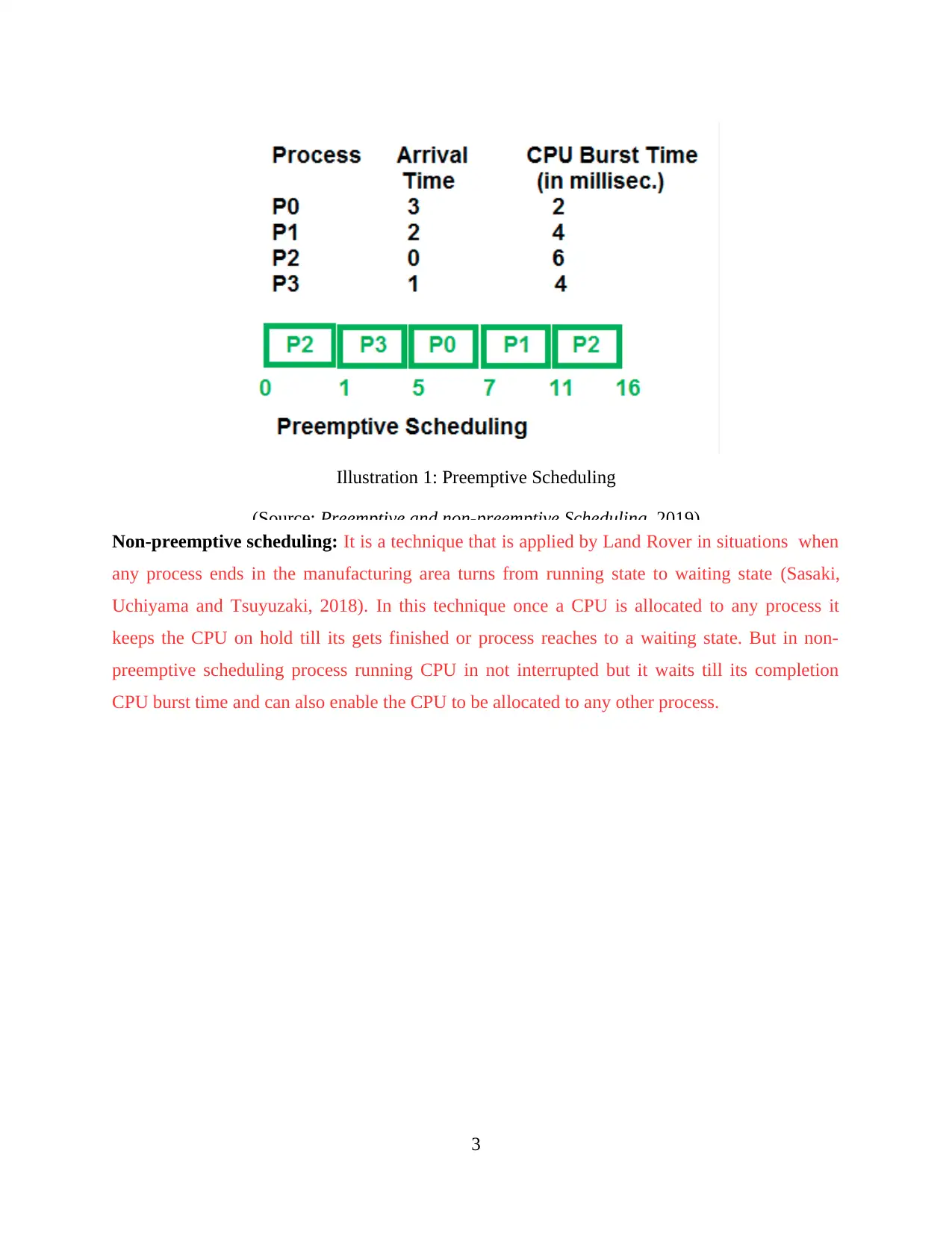
Illustration 1: Preemptive Scheduling
(Source: Preemptive and non-preemptive Scheduling, 2019)
Non-preemptive scheduling: It is a technique that is applied by Land Rover in situations when
any process ends in the manufacturing area turns from running state to waiting state (Sasaki,
Uchiyama and Tsuyuzaki, 2018). In this technique once a CPU is allocated to any process it
keeps the CPU on hold till its gets finished or process reaches to a waiting state. But in non-
preemptive scheduling process running CPU in not interrupted but it waits till its completion
CPU burst time and can also enable the CPU to be allocated to any other process.
3
(Source: Preemptive and non-preemptive Scheduling, 2019)
Non-preemptive scheduling: It is a technique that is applied by Land Rover in situations when
any process ends in the manufacturing area turns from running state to waiting state (Sasaki,
Uchiyama and Tsuyuzaki, 2018). In this technique once a CPU is allocated to any process it
keeps the CPU on hold till its gets finished or process reaches to a waiting state. But in non-
preemptive scheduling process running CPU in not interrupted but it waits till its completion
CPU burst time and can also enable the CPU to be allocated to any other process.
3
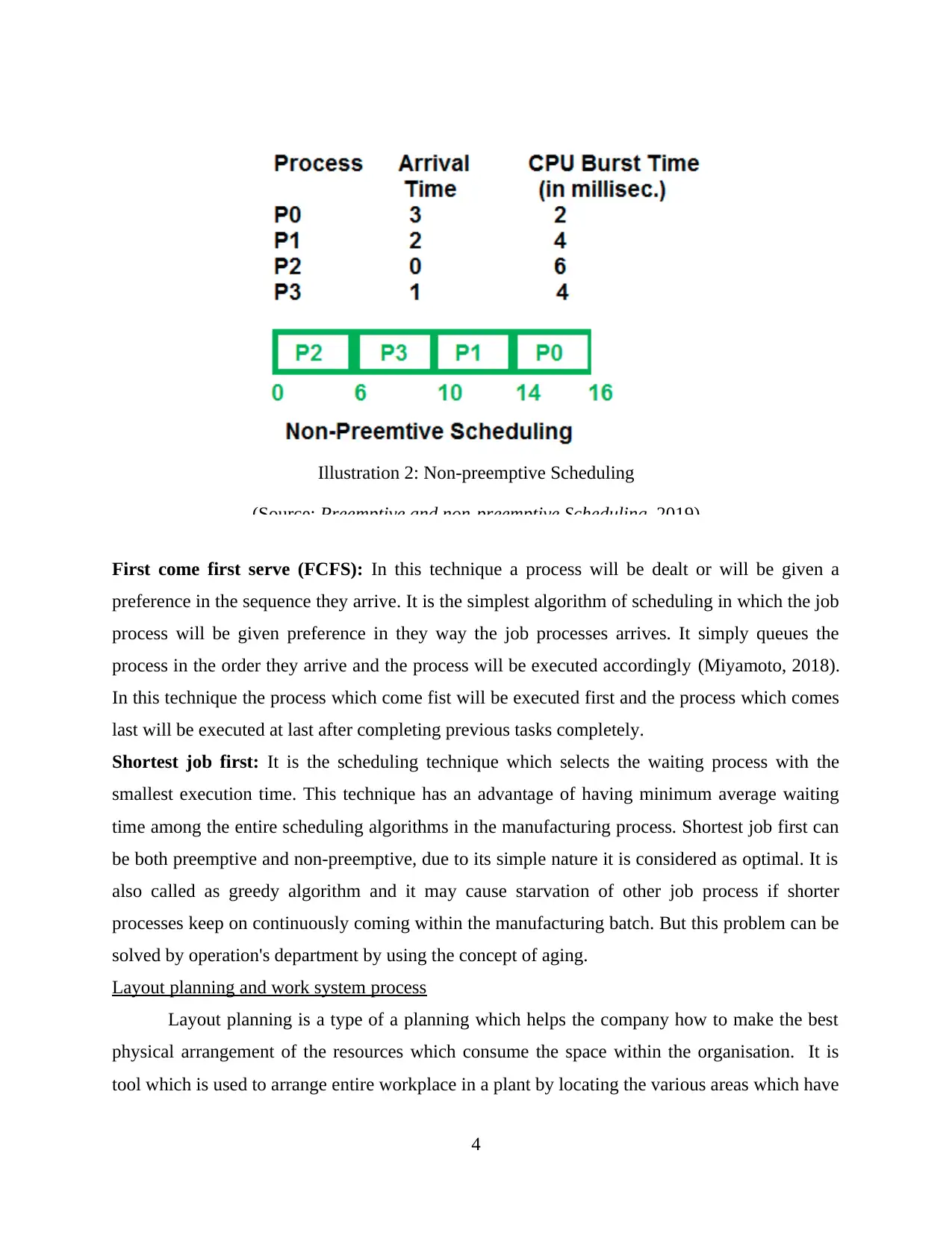
Illustration 2: Non-preemptive Scheduling
(Source: Preemptive and non-preemptive Scheduling, 2019)
First come first serve (FCFS): In this technique a process will be dealt or will be given a
preference in the sequence they arrive. It is the simplest algorithm of scheduling in which the job
process will be given preference in they way the job processes arrives. It simply queues the
process in the order they arrive and the process will be executed accordingly (Miyamoto, 2018).
In this technique the process which come fist will be executed first and the process which comes
last will be executed at last after completing previous tasks completely.
Shortest job first: It is the scheduling technique which selects the waiting process with the
smallest execution time. This technique has an advantage of having minimum average waiting
time among the entire scheduling algorithms in the manufacturing process. Shortest job first can
be both preemptive and non-preemptive, due to its simple nature it is considered as optimal. It is
also called as greedy algorithm and it may cause starvation of other job process if shorter
processes keep on continuously coming within the manufacturing batch. But this problem can be
solved by operation's department by using the concept of aging.
Layout planning and work system process
Layout planning is a type of a planning which helps the company how to make the best
physical arrangement of the resources which consume the space within the organisation. It is
tool which is used to arrange entire workplace in a plant by locating the various areas which have
4
(Source: Preemptive and non-preemptive Scheduling, 2019)
First come first serve (FCFS): In this technique a process will be dealt or will be given a
preference in the sequence they arrive. It is the simplest algorithm of scheduling in which the job
process will be given preference in they way the job processes arrives. It simply queues the
process in the order they arrive and the process will be executed accordingly (Miyamoto, 2018).
In this technique the process which come fist will be executed first and the process which comes
last will be executed at last after completing previous tasks completely.
Shortest job first: It is the scheduling technique which selects the waiting process with the
smallest execution time. This technique has an advantage of having minimum average waiting
time among the entire scheduling algorithms in the manufacturing process. Shortest job first can
be both preemptive and non-preemptive, due to its simple nature it is considered as optimal. It is
also called as greedy algorithm and it may cause starvation of other job process if shorter
processes keep on continuously coming within the manufacturing batch. But this problem can be
solved by operation's department by using the concept of aging.
Layout planning and work system process
Layout planning is a type of a planning which helps the company how to make the best
physical arrangement of the resources which consume the space within the organisation. It is
tool which is used to arrange entire workplace in a plant by locating the various areas which have
4
⊘ This is a preview!⊘
Do you want full access?
Subscribe today to unlock all pages.

Trusted by 1+ million students worldwide
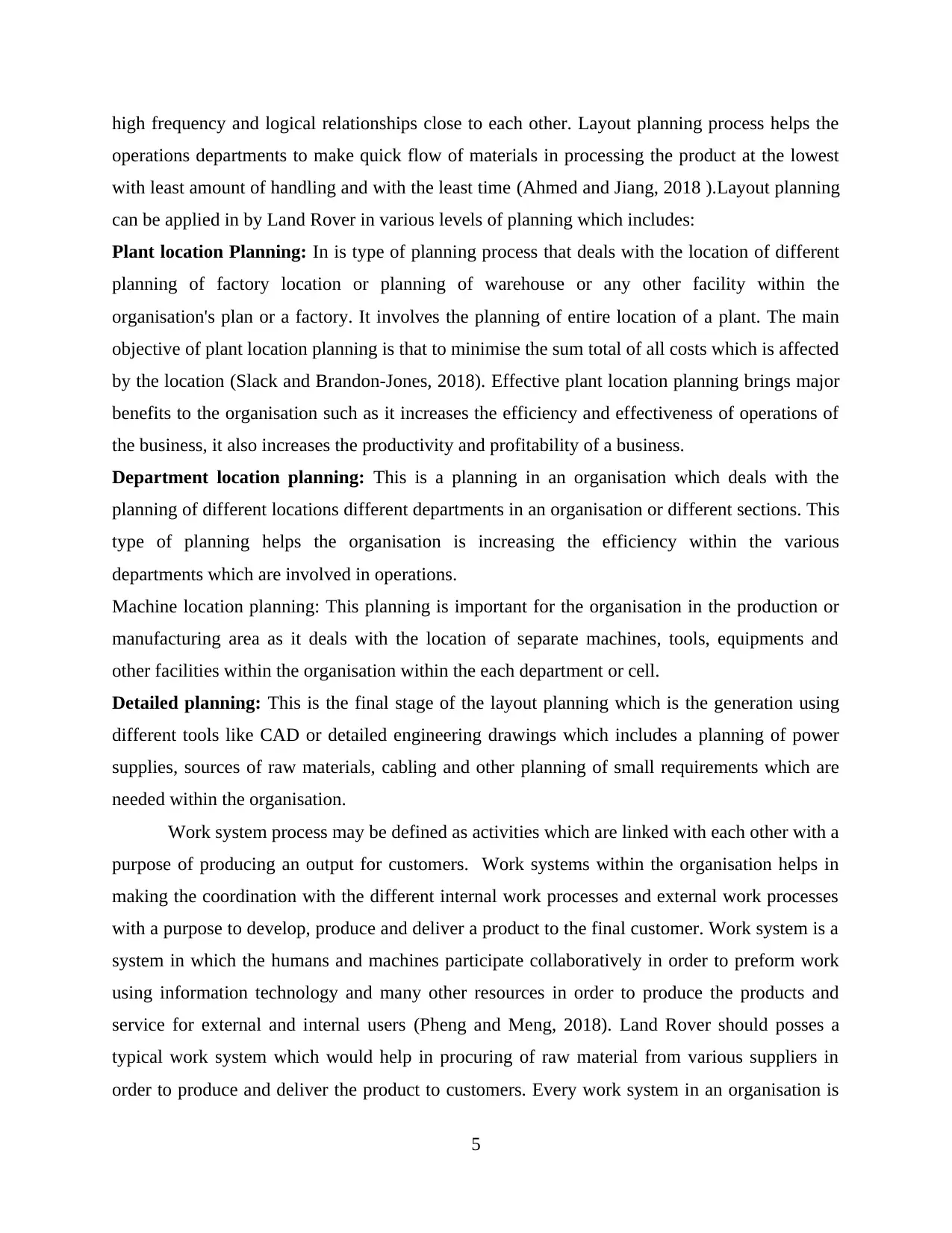
high frequency and logical relationships close to each other. Layout planning process helps the
operations departments to make quick flow of materials in processing the product at the lowest
with least amount of handling and with the least time (Ahmed and Jiang, 2018 ).Layout planning
can be applied in by Land Rover in various levels of planning which includes:
Plant location Planning: In is type of planning process that deals with the location of different
planning of factory location or planning of warehouse or any other facility within the
organisation's plan or a factory. It involves the planning of entire location of a plant. The main
objective of plant location planning is that to minimise the sum total of all costs which is affected
by the location (Slack and Brandon-Jones, 2018). Effective plant location planning brings major
benefits to the organisation such as it increases the efficiency and effectiveness of operations of
the business, it also increases the productivity and profitability of a business.
Department location planning: This is a planning in an organisation which deals with the
planning of different locations different departments in an organisation or different sections. This
type of planning helps the organisation is increasing the efficiency within the various
departments which are involved in operations.
Machine location planning: This planning is important for the organisation in the production or
manufacturing area as it deals with the location of separate machines, tools, equipments and
other facilities within the organisation within the each department or cell.
Detailed planning: This is the final stage of the layout planning which is the generation using
different tools like CAD or detailed engineering drawings which includes a planning of power
supplies, sources of raw materials, cabling and other planning of small requirements which are
needed within the organisation.
Work system process may be defined as activities which are linked with each other with a
purpose of producing an output for customers. Work systems within the organisation helps in
making the coordination with the different internal work processes and external work processes
with a purpose to develop, produce and deliver a product to the final customer. Work system is a
system in which the humans and machines participate collaboratively in order to preform work
using information technology and many other resources in order to produce the products and
service for external and internal users (Pheng and Meng, 2018). Land Rover should posses a
typical work system which would help in procuring of raw material from various suppliers in
order to produce and deliver the product to customers. Every work system in an organisation is
5
operations departments to make quick flow of materials in processing the product at the lowest
with least amount of handling and with the least time (Ahmed and Jiang, 2018 ).Layout planning
can be applied in by Land Rover in various levels of planning which includes:
Plant location Planning: In is type of planning process that deals with the location of different
planning of factory location or planning of warehouse or any other facility within the
organisation's plan or a factory. It involves the planning of entire location of a plant. The main
objective of plant location planning is that to minimise the sum total of all costs which is affected
by the location (Slack and Brandon-Jones, 2018). Effective plant location planning brings major
benefits to the organisation such as it increases the efficiency and effectiveness of operations of
the business, it also increases the productivity and profitability of a business.
Department location planning: This is a planning in an organisation which deals with the
planning of different locations different departments in an organisation or different sections. This
type of planning helps the organisation is increasing the efficiency within the various
departments which are involved in operations.
Machine location planning: This planning is important for the organisation in the production or
manufacturing area as it deals with the location of separate machines, tools, equipments and
other facilities within the organisation within the each department or cell.
Detailed planning: This is the final stage of the layout planning which is the generation using
different tools like CAD or detailed engineering drawings which includes a planning of power
supplies, sources of raw materials, cabling and other planning of small requirements which are
needed within the organisation.
Work system process may be defined as activities which are linked with each other with a
purpose of producing an output for customers. Work systems within the organisation helps in
making the coordination with the different internal work processes and external work processes
with a purpose to develop, produce and deliver a product to the final customer. Work system is a
system in which the humans and machines participate collaboratively in order to preform work
using information technology and many other resources in order to produce the products and
service for external and internal users (Pheng and Meng, 2018). Land Rover should posses a
typical work system which would help in procuring of raw material from various suppliers in
order to produce and deliver the product to customers. Every work system in an organisation is
5
Paraphrase This Document
Need a fresh take? Get an instant paraphrase of this document with our AI Paraphraser
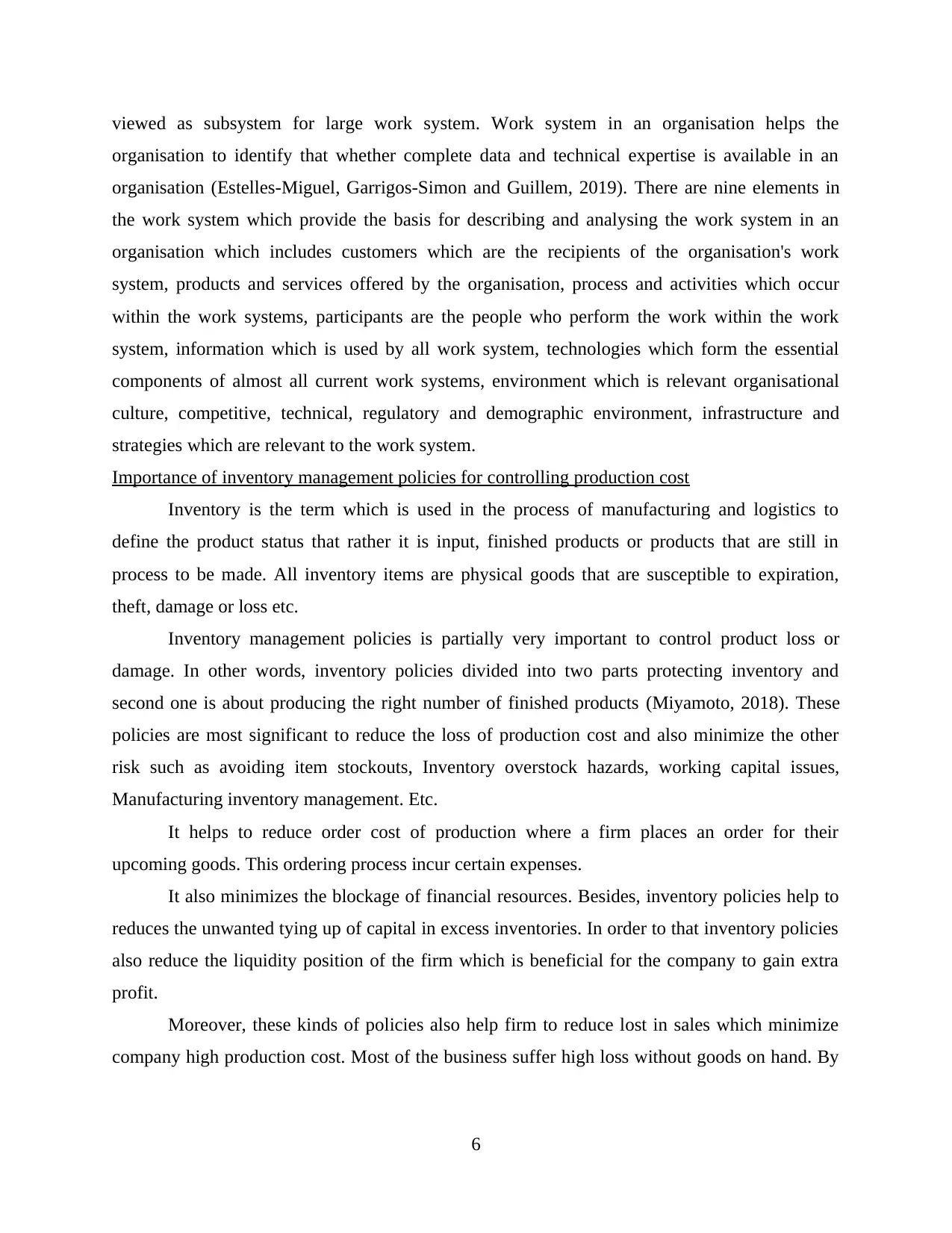
viewed as subsystem for large work system. Work system in an organisation helps the
organisation to identify that whether complete data and technical expertise is available in an
organisation (Estelles-Miguel, Garrigos-Simon and Guillem, 2019). There are nine elements in
the work system which provide the basis for describing and analysing the work system in an
organisation which includes customers which are the recipients of the organisation's work
system, products and services offered by the organisation, process and activities which occur
within the work systems, participants are the people who perform the work within the work
system, information which is used by all work system, technologies which form the essential
components of almost all current work systems, environment which is relevant organisational
culture, competitive, technical, regulatory and demographic environment, infrastructure and
strategies which are relevant to the work system.
Importance of inventory management policies for controlling production cost
Inventory is the term which is used in the process of manufacturing and logistics to
define the product status that rather it is input, finished products or products that are still in
process to be made. All inventory items are physical goods that are susceptible to expiration,
theft, damage or loss etc.
Inventory management policies is partially very important to control product loss or
damage. In other words, inventory policies divided into two parts protecting inventory and
second one is about producing the right number of finished products (Miyamoto, 2018). These
policies are most significant to reduce the loss of production cost and also minimize the other
risk such as avoiding item stockouts, Inventory overstock hazards, working capital issues,
Manufacturing inventory management. Etc.
It helps to reduce order cost of production where a firm places an order for their
upcoming goods. This ordering process incur certain expenses.
It also minimizes the blockage of financial resources. Besides, inventory policies help to
reduces the unwanted tying up of capital in excess inventories. In order to that inventory policies
also reduce the liquidity position of the firm which is beneficial for the company to gain extra
profit.
Moreover, these kinds of policies also help firm to reduce lost in sales which minimize
company high production cost. Most of the business suffer high loss without goods on hand. By
6
organisation to identify that whether complete data and technical expertise is available in an
organisation (Estelles-Miguel, Garrigos-Simon and Guillem, 2019). There are nine elements in
the work system which provide the basis for describing and analysing the work system in an
organisation which includes customers which are the recipients of the organisation's work
system, products and services offered by the organisation, process and activities which occur
within the work systems, participants are the people who perform the work within the work
system, information which is used by all work system, technologies which form the essential
components of almost all current work systems, environment which is relevant organisational
culture, competitive, technical, regulatory and demographic environment, infrastructure and
strategies which are relevant to the work system.
Importance of inventory management policies for controlling production cost
Inventory is the term which is used in the process of manufacturing and logistics to
define the product status that rather it is input, finished products or products that are still in
process to be made. All inventory items are physical goods that are susceptible to expiration,
theft, damage or loss etc.
Inventory management policies is partially very important to control product loss or
damage. In other words, inventory policies divided into two parts protecting inventory and
second one is about producing the right number of finished products (Miyamoto, 2018). These
policies are most significant to reduce the loss of production cost and also minimize the other
risk such as avoiding item stockouts, Inventory overstock hazards, working capital issues,
Manufacturing inventory management. Etc.
It helps to reduce order cost of production where a firm places an order for their
upcoming goods. This ordering process incur certain expenses.
It also minimizes the blockage of financial resources. Besides, inventory policies help to
reduces the unwanted tying up of capital in excess inventories. In order to that inventory policies
also reduce the liquidity position of the firm which is beneficial for the company to gain extra
profit.
Moreover, these kinds of policies also help firm to reduce lost in sales which minimize
company high production cost. Most of the business suffer high loss without goods on hand. By
6
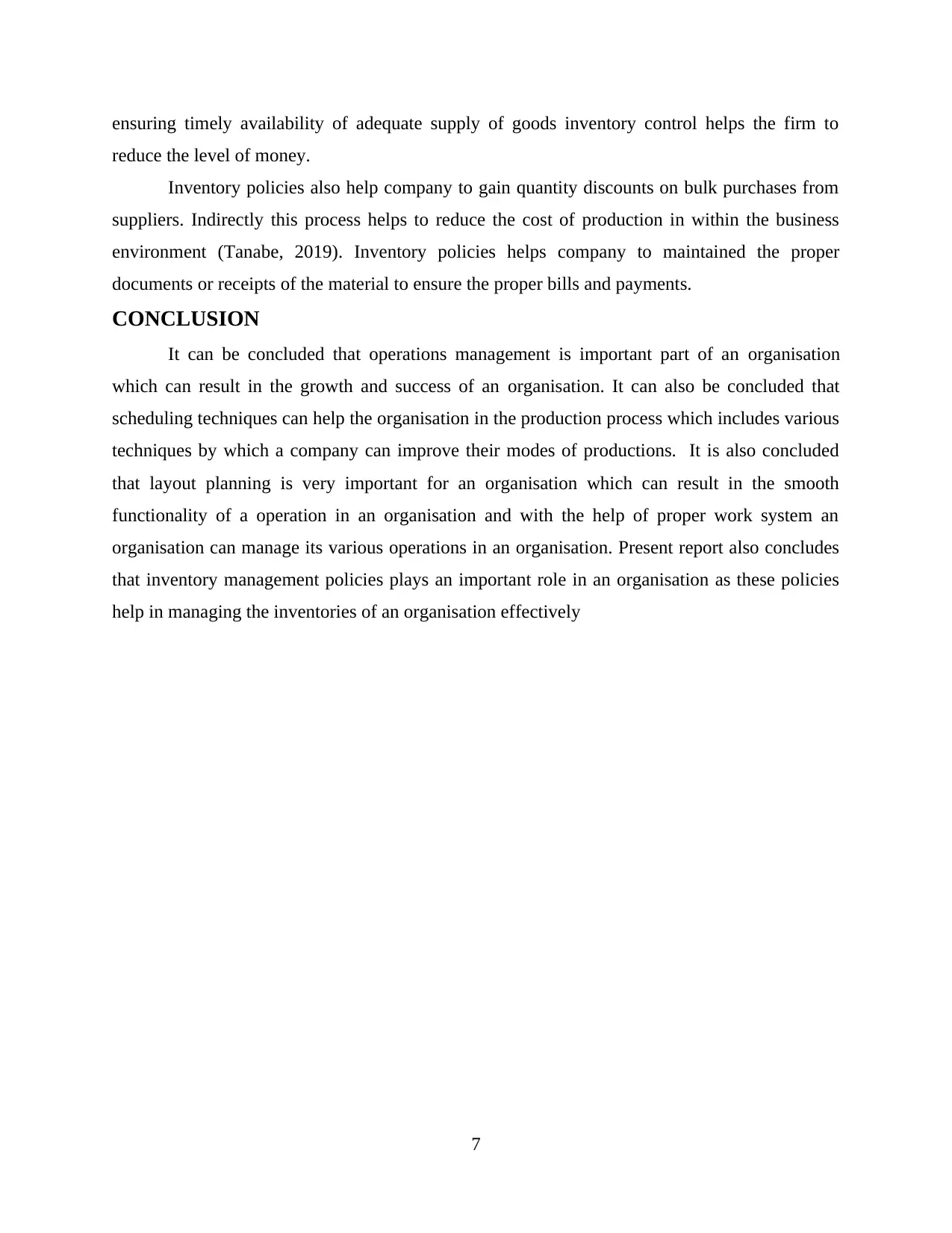
ensuring timely availability of adequate supply of goods inventory control helps the firm to
reduce the level of money.
Inventory policies also help company to gain quantity discounts on bulk purchases from
suppliers. Indirectly this process helps to reduce the cost of production in within the business
environment (Tanabe, 2019). Inventory policies helps company to maintained the proper
documents or receipts of the material to ensure the proper bills and payments.
CONCLUSION
It can be concluded that operations management is important part of an organisation
which can result in the growth and success of an organisation. It can also be concluded that
scheduling techniques can help the organisation in the production process which includes various
techniques by which a company can improve their modes of productions. It is also concluded
that layout planning is very important for an organisation which can result in the smooth
functionality of a operation in an organisation and with the help of proper work system an
organisation can manage its various operations in an organisation. Present report also concludes
that inventory management policies plays an important role in an organisation as these policies
help in managing the inventories of an organisation effectively
7
reduce the level of money.
Inventory policies also help company to gain quantity discounts on bulk purchases from
suppliers. Indirectly this process helps to reduce the cost of production in within the business
environment (Tanabe, 2019). Inventory policies helps company to maintained the proper
documents or receipts of the material to ensure the proper bills and payments.
CONCLUSION
It can be concluded that operations management is important part of an organisation
which can result in the growth and success of an organisation. It can also be concluded that
scheduling techniques can help the organisation in the production process which includes various
techniques by which a company can improve their modes of productions. It is also concluded
that layout planning is very important for an organisation which can result in the smooth
functionality of a operation in an organisation and with the help of proper work system an
organisation can manage its various operations in an organisation. Present report also concludes
that inventory management policies plays an important role in an organisation as these policies
help in managing the inventories of an organisation effectively
7
⊘ This is a preview!⊘
Do you want full access?
Subscribe today to unlock all pages.

Trusted by 1+ million students worldwide

REFERENCES
Books and Journals
Seddighi, H. and Mathew, S., 2018. Firm’s core competence and output characteristics: An
empirical framework for operation management of innovation. Journal of Operations
Management.
Tanabe, M., FANUC Corporation, 2019. Operation management system for directly displaying
work instruction based on operation management information on machine tool. U.S. Patent
Application 15/371,498.
Yamashita, A. and Kimura, K., Isuzu Motors Ltd, 2019. Operation management device,
operation management method and operation management system. U.S. Patent Application
16/100,066.
Sugiyama, K. and Iba, S., Honda Motor Co Ltd, 2018. Operation management system for
autonomous mobile robots. U.S. Patent Application 15/821,968.
Sasaki, H., Uchiyama, N. and Tsuyuzaki, M., Hitachi Ltd, 2018. Consumer apparatus operation
management system and method. U.S. Patent 9,935,461.
Miyamoto, K., FUJIFILM Corp, 2018. Operation management system, control system and
operation control method. U.S. Patent 9,860,746.
Ahmed, A. and Jiang, T., 2018, October. Operation Management of Power Grid System with
Renewable Energy Sources and Energy Storage System Integrations. In 2018 2nd IEEE
Conference on Energy Internet and Energy System Integration (EI2) (pp. 1-6). IEEE.
Slack, N. and Brandon-Jones, A., 2018. Operations and process management: principles and
practice for strategic impact. Pearson UK.
Pheng, L.S. and Meng, C.Y., 2018. Managing productivity in construction: JIT operations and
measurements. Routledge.
8
Books and Journals
Seddighi, H. and Mathew, S., 2018. Firm’s core competence and output characteristics: An
empirical framework for operation management of innovation. Journal of Operations
Management.
Tanabe, M., FANUC Corporation, 2019. Operation management system for directly displaying
work instruction based on operation management information on machine tool. U.S. Patent
Application 15/371,498.
Yamashita, A. and Kimura, K., Isuzu Motors Ltd, 2019. Operation management device,
operation management method and operation management system. U.S. Patent Application
16/100,066.
Sugiyama, K. and Iba, S., Honda Motor Co Ltd, 2018. Operation management system for
autonomous mobile robots. U.S. Patent Application 15/821,968.
Sasaki, H., Uchiyama, N. and Tsuyuzaki, M., Hitachi Ltd, 2018. Consumer apparatus operation
management system and method. U.S. Patent 9,935,461.
Miyamoto, K., FUJIFILM Corp, 2018. Operation management system, control system and
operation control method. U.S. Patent 9,860,746.
Ahmed, A. and Jiang, T., 2018, October. Operation Management of Power Grid System with
Renewable Energy Sources and Energy Storage System Integrations. In 2018 2nd IEEE
Conference on Energy Internet and Energy System Integration (EI2) (pp. 1-6). IEEE.
Slack, N. and Brandon-Jones, A., 2018. Operations and process management: principles and
practice for strategic impact. Pearson UK.
Pheng, L.S. and Meng, C.Y., 2018. Managing productivity in construction: JIT operations and
measurements. Routledge.
8
Paraphrase This Document
Need a fresh take? Get an instant paraphrase of this document with our AI Paraphraser

Estelles-Miguel, S., Garrigos-Simon, J.F., Gato, M.E.P. and Guillem, J.M.A., 2019. Another
Way to Teach Operation Management. In Engineering Digital Transformation (pp. 219-
225). Springer, Cham.
Miyamoto, K., FUJIFILM Corp, 2018. Operation management system, control system and
operation control method. U.S. Patent 9,860,746.
Tanabe, M., FANUC Corporation, 2019. Operation management system for directly displaying
work instruction based on operation management information on machine tool. U.S. Patent
Application 15/371,498.
Online
Preemptive and Non-Preemptive Scheduling. 2019. [Online]. Available Through:
<https://www.geeksforgeeks.org/preemptive-and-non-preemptive-scheduling/>.
9
Way to Teach Operation Management. In Engineering Digital Transformation (pp. 219-
225). Springer, Cham.
Miyamoto, K., FUJIFILM Corp, 2018. Operation management system, control system and
operation control method. U.S. Patent 9,860,746.
Tanabe, M., FANUC Corporation, 2019. Operation management system for directly displaying
work instruction based on operation management information on machine tool. U.S. Patent
Application 15/371,498.
Online
Preemptive and Non-Preemptive Scheduling. 2019. [Online]. Available Through:
<https://www.geeksforgeeks.org/preemptive-and-non-preemptive-scheduling/>.
9
1 out of 11
Related Documents
Your All-in-One AI-Powered Toolkit for Academic Success.
+13062052269
info@desklib.com
Available 24*7 on WhatsApp / Email
![[object Object]](/_next/static/media/star-bottom.7253800d.svg)
Unlock your academic potential
Copyright © 2020–2025 A2Z Services. All Rights Reserved. Developed and managed by ZUCOL.





